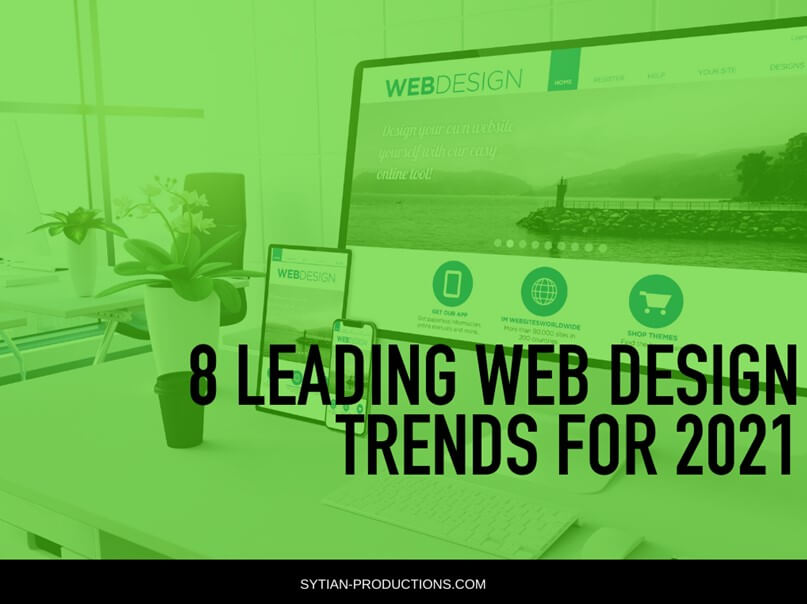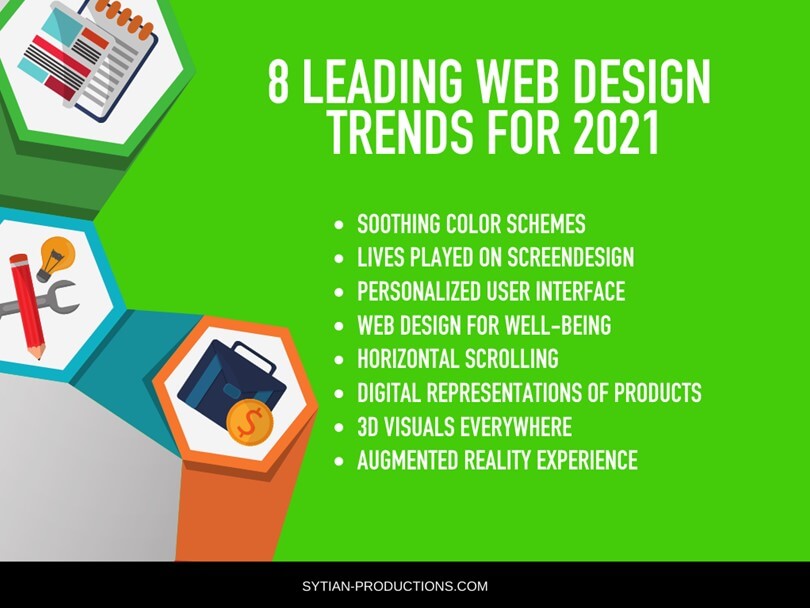8 Leading Web Design Trends for 2021
Web design is continuously innovating each year and the uncertainties that the previous year have brought us impacted our lives.
One of the biggest changes this year was the fast move towards the virtual world which led to digital advancements and developments as the increasing number of people adapted and relied on working from home, online services, conferencing, and shopping.

So, what should we expect in 2021? The web design trends for this year appear to have a common theme which is the push for virtual realism. This can be witnessed by the mixture of the ordinary and digital things that reflects one’s daily life.
Therefore, you can expect eight of the leading web design trends to breathe life into the evolving digital world. Here are those:

Soothing Color Schemes
More people are now spending the majority of their time facing their computers, this is due to the digital nature of their jobs and daily life requirements in general. For this reason, it is not uncommon for these users to suffer from eye strain from being on their gadgets and looking at their screens for long periods of time.
In turn, we designers have taken this into consideration and have come up with color schemes that are more eye-friendly.
This is one of the reasons why the dark mode trend from the previous year has become popular to users as this mode counteracted whiteness from screen-based media.
This year, web designers will find the balance between dark and light. Soft color palettes like pastel blue, light pink, warm brown, and relaxing green will help them find the middle ground.
Lives Played on Screen
As the COVID-19 pandemic pushed more people to the new normal, you can expect to see more lives played out on screens. You’ll see more members of the digital community come up and share immersive experiences that are considered as good as the real thing.
During the previous year, we all got to watch live streaming concerts with rich visual effects and this is where web design comes in. It is predicted that there will be an increase in designs that are quirky and more personal like a custom cursor, organic shapes, animated transitions, and more prominent types.
Personalized User Interface
This has been something that has been heard of during the past years but it has now become a general feature for websites. You’ll see more web designers creating modifiable and modular user interfaces (IU) that consider the different types of users and how personalization could benefit them.
As you can imagine, UIs are unique to each user which reflects their preference, identities, and styles. Having a personalized UI leads to inclusive web design.
Web Design for Well-Being
The uncertainties of the year 2020 have reminded everyone about the importance of their physical and mental health. This is the reason why web designers are also focusing on addressing these essential factors through design.
You’ll see more web designers prioritizing mental health by using happy, funny, and calming visuals that would be replacing the clinical-looking ones. Energetic and vibrant color schemes are great for sending friendly and positive vibes to users.
Horizontal Scrolling
This has been done before and is now making a comeback. More and more web designers are continuously learning and experimenting in this area.
Horizontal scrolling is an excellent way of displaying secondary information, just like browsing through an image gallery.
It is important, however, to keep in mind to put into consideration what content should be displayed through horizontal scrolling and text that needs to be read should be used carefully. Also, you shouldn’t force your users to navigate through this kind of scrolling. Designing a web with alternative ways to scroll is the best way to allow them to adapt.
Digital Representations of Products
Often, products are the main heart and soul of a website, and this year, you’ll see more digital representations of products through media.
You can expect to see bold colors that interpret the products, this is a perfect synergy of creating visuals between the website and the products, making the pages feel more unique and yet organic.
Blending in digital and the real world is indeed right in this kind of time, where a huge shift of changes is happening, especially with how people interact with a website.
3D Visuals Everywhere
The advent of a higher resolution screen is paving the way for the advancement of 3D visuals and designs. These designs are weaved carefully into websites, adding to the overall user experience.
3D experience also opens up a boost in productivity and creativity through a colorful layout of 3D gradients, drop shadows, layered elements, and shapes. enticing more users to be more interactive with a website.
Augmented Reality Experience
Augmented Reality (AR) brings immersive experiences to users. There’s more to AR than using it for games, but companies are also experimenting on how this can be used to improve shopping experiences for online shoppers.
Retail and eCommerce websites are tapping into AR to help them sell their products and increase their sales. This also helps their customers feel empowered even if they are online hunting for products they need. AR is now used in the automobile and clothing industries too.
To sum it all up. The future of web design for this year is looking less like it’s been taken out of a sci-fi movie, but rather taken from the context of everyday, real lives of users.
You can expect more exciting web design development used by various industries. The changes being made show how increasingly websites are becoming part of one’s life. Web design has become more considerate of human interaction and the value of its connection to businesses.
Indeed, web design changes are always exciting because they are reflections of the users’ experiences and how they are adapting to the changes around them. This is how designers are able to create designs that answer to the user experience demands. How web designers are facing the challenge to address user and business concerns and requirements.